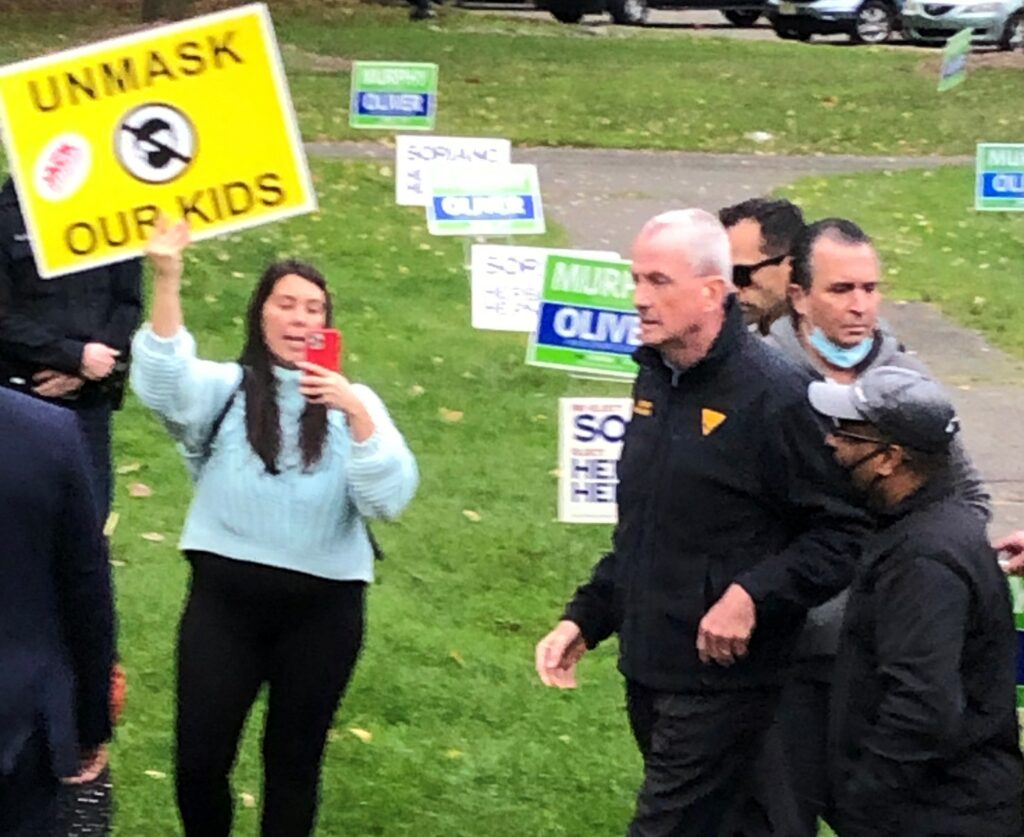Murphy Needs to Confront the Anger out there

In his post-election media tour, Gov. Phil Murphy explained his narrow re-election victory margin and the unanticipated dismal showing of Democrats generally with another of his seemingly endless supply of cliches: “There’s a lot of hurt out there.”
Hurt? Maybe. Anger? Definitely.
His less than three-point margin over Republican challenger Jack Ciattarelli wasn’t assured until tens of thousands of mail in ballots were tabulated and turned the race from a potential seismic upset to an uncomfortably narrow escape in a reliably blue state.
The outcome, the governor suggested, would have been worse had it not been for his Administration’s first term accomplishments — raising the minimum wage, imposing a tax increase on millionaires, and expanding pre-K education and child care services.
Flipping through his thesaurus of cliches, Murphy offered up “there’s a lot of kitchen tables” to connect with, although he didn’t elaborate just what would be discussed over coffee and croissants to ameliorate the hurt.
Reading from the same volume, Murphy promised to “move forward, not backward” in his second term, a meaningless pledge since there’s no record of any candidate for any office pledging to “move backward, not forward.”
Anger in various degrees is always a driving motivation in elections, an emotion that inevitably results in voters focusing their wrath on those in political and governmental leadership roles — in this case, President Biden and his Democratic colleagues.
The Biden Administration’s free fall in public approval, driven largely by out-of-control inflationary pressures, contributed to Murphy’s close call and arguably turned the governor’s race in Virginia into a Republican victory.
In many cases, essential everyday commodity prices from a gallon of gasoline to a gallon of milk have risen by double digit percentages, wiping out wage gains and imposing additional financial burdens on American families.
A pandemic-weary America having endured nearly two years of lockdowns, school closures, businesses failures, travel and public gathering restrictions, commodity shortages, and vitriolic arguments over mask wearing and vaccinations turned sour on an Administration whose responses were too often in conflict and contradictory.
Voter reaction was driven also by the perception that the White House appeared bereft of any ideas to ease inflation or to unclog a slowing choking supply chain while abandoning moderate centrist policies in favor of the fringe left demands.
The issues close to the hearts of Congressional progressives — de-funding police while violent crime is on the rise, opening borders, massive and enormously costly social welfare expansions — proved to be drag on Democrats and filtered down to state and local races, including Murphy’s.
The drawn out argument over the multi trillion dollar infrastructure package — still not fully resolved — added to the image of an Administration in disarray, incapable of forging a truce in the intra-party ideological clash or negotiating compromises to enact the Administration’s signature domestic agenda item.
In light of the easily identified national mood, Murphy’s campaign strategy of bringing in the president, First Lady and Vermont socialist Sen. Bernie Sanders while proudly proclaiming himself the most progressive governor in the nation badly misinterpreted voter temperament.
While these issues are, of course, beyond Murphy’s control, he became collateral damage by seeking re-election at the height of boiling discontent with his party, an inviting target for voters to lash out and relieve pent up frustrations.
It wasn’t quite the torches and pitchfork crowd (my cliché, not Murphy’s) marching on the Statehouse, but those feelings bubbled close to the surface even as Murphy maintained majority public support for his handling of the pandemic.
Murphy tiptoed along the edge of the abyss while Democrats lost six Assembly seats and suffered a net loss of one Senate seat, notably the stunning upset of Senate President Steve Sweeney (D-Gloucester) by an unknown Republican whose major campaign expenditure covered the cost of doughnuts for poll workers.
Ciattarelli, the loser, had coattails while Murphy, the winner, did not; a definition of the angry voter who vented by voting for the opposition party or skipping election day altogether.
That theory was underscored by post-election analyses which revealed that Ciattarelli overperformed in many regions of the state while Murphy underperformed, a movement missed by polling organizations.
Moreover, the historic low turnout of 37 percent hurt Murphy, a casualty of the Democratic Party’s get out the vote (GOTV) effort which turned out to have been long on cheerful promise and woefully short on performance.
Murphy coasted to a 15-point victory four years ago and looked forward optimistically to a double digit mandate this year. There were no mandate claims on election night nor since.
The landscape is not entirely gloomy. He still enjoys clear — though shrunken — majorities in the Legislature whose 120 members face re-election in two years and are understandably anxious to build a record while Murphy enters lame duck territory.
Increasing identity and establishing records is even more crucial since candidates in 2023 will be competing in newly configured and unfamiliar legislative districts as a result of reapportionment.
It also means increased jockeying and elbow throwing to gain a position of advantage to seek the open gubernatorial seat in 2025, by which time the odds are Biden will be out of office likely as a result at age 82 of not seeking re-election.
Murphy has promised unequivocally he intends to fill his forthcoming four years, expressing no interest in presidential politics although speculation about his joining a Democratic administration at cabinet level will certainly heat up as he enters his final year in Trenton.
Easing the hurt he’s perceived and identified as the culprit in his close call will occupy his second term and drive his agenda.
It would be to his distinct advantage as well to acknowledge the anger out there as more difficult to overcome than the hurt.
Carl Golden is a senior contributing analyst with the William J. Hughes Center for Public Policy at Stockton University.










“His less than three-point margin over Republican challenger Jack Ciattarelli wasn’t assured until tens of thousands of mail in ballots were tabulated …”
First, Murphy had 51.2% of the vote, and Ciattarelli had 48.0%. That’s more than three points, not less.
Second, Murphy got 130,000 MORE votes in 2021 than in 2017. The difference was Republicans weren’t depressed by Trump and Christie this time, so they turned out. Still, 94,000 more New Jersey voters went for Murphy. It’s also the first time a Dem has won with a Dem in the White House and the first Democrat to win reelection as Governor since 1977.
Third, the reason why the final margin came about when mail-in ballots were counted was because Democrats had a strategy of encouraging early voting by mail or in-person. The way the count went was planned, and expected from election night on.
And let’s not forget Kean won by just over 17K votes in 1981. Whitman won by 1% in 1993, reelection by 1.1% in 1997 and didn’t get to 50% in either race. Neither Kean, Whitman, or Christie won 50% of the vote in their first race, but Corzine won 56 and 51% respectively.
As for the price of milk, here’s the USDA pricing
Whole Milk January: $3.61
Whole Milk November: $3.72 ($3.69 in October during voting)
2% Milk January: $3.57
2% Milk November: $3.69 ($3.65 in October during voting)
Organic Whole Milk January: $4.10
Organic Whole Milk November: $4.20 ($4.21 in October during voting)
Gas prices are up, true, but milk is pretty flat. Oat milk for the lactose intolerant hasn’t gone up at all.